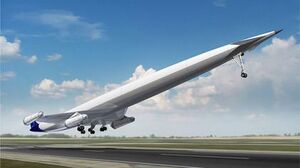Engineering:Reaction Engines A2
| A2 | |
|---|---|

| |
| Artist's concept of the Reaction Engines A2 | |
| Role | Hypersonic Airliner |
| National origin | United Kingdom |
| Manufacturer | Undetermined |
| Designer | Reaction Engines Limited |
| Status | Design study |
The Reaction Engines Limited LAPCAT Configuration A2 (called the LAPCAT A2) is a design study for a hypersonic speed jet airliner intended to provide environmentally friendly, long range, high capacity commercial transportation. The aircraft was designed by the United Kingdom aerospace engineering firm Reaction Engines Limited, who claim it could be developed into a working aircraft within 25 years once there is market demand for it. The aircraft was designed as part of the LAPCAT programme of the European Union, but has not yet been commercially launched.
Development
The vehicle is intended to have about 20,000 kilometres (12,000 mi) range and good subsonic and supersonic speed fuel efficiency, thus avoiding the problems inherent in earlier supersonic aircraft. The top speed is projected to be Mach 5+. It calls for the use of liquid hydrogen as a fuel, which has twice the specific impulse of kerosene, and can be used to cool the vehicle and the air entering the engines via a precooler.
Our work shows that it is possible technically; now it's up to the world to decide if it wants it.— Alan Bond, managing director of Reaction Engines Limited
The developers say it would be able to fly from Brussels to Sydney in about 4.6 hours, compared to around a complete day of travel with normal aircraft. The cost of a ticket is intended to be roughly business class level.[1]
Design
Capabilities
According to Alan Bond, the A2 design could fly subsonically from Brussels International Airport into the North Atlantic then reaching Mach 5 across the North Pole and over the Pacific to Australia .[2]
The great circle route is not used in this example because the route travels mostly over land. The sonic boom generated by travelling at supersonic speed can cause great discomfort for people on the ground, which was why Concorde was prohibited from flying supersonically over land.
Another advantage of the design is that, while the 143 metre-long A2 is much longer than conventional jets, it would be lighter than a Boeing 747 and could take off and land on current airport runways.
However, the A2 design does not have windows. The heat generated by the hypersonic airflow over the body puts constraints on window design which would make them too heavy. One solution Reaction Engines has proposed is to install flat panel displays, showing images of the scene outside.
Engines
The Scimitar engines use related technology to the company's earlier SABRE engine, which is intended for space launch, but here adapted for very long distance, very high speed travel.
Normally, as air enters a jet engine, it is compressed by the inlet, and thus heats up. It needs much more power to compress that heated air further by the engine's compressor section, which reduces the compressor's efficiency dramatically. Furthermore, this means that high-speed engines need to be made of materials that can survive extremely high temperatures. In practice, this inevitably makes the engines heavier and also reduces the amount of fuel that can be burned, to avoid melting the gas turbine section of the engine. This in turn reduces thrust at high speed.
The key design feature for the Scimitar engines is the precooler, which is a heat exchanger that transfers the heat from the incoming air into the hydrogen fuel. This greatly cools the air, which allows the engines to burn more fuel even at very high speed, and allows the engines to be made of lighter, but more heat susceptible, materials such as light alloys. The engine inlet diffuser also has to slow the incoming air to subsonic speeds because if the air moved through the precooler and compressor at supersonic speeds, it would cause damage to them.
The rest of the engine is described as having high-bypass (4:1[3]) turbofan engine features to give it good efficiency and subsonic (quiet) exhaust velocity at low speeds. Unlike SABRE the A2's Scimitar engine would not have rocket engine features.
Specifications (LAPCAT A2)
Data from Reaction engines[4]
General characteristics
- Capacity: 300 passengers (plus baggage)
- Length: 139 m (456 ft 0 in)
- Wingspan: 41 m (134 ft 6 in)
- Wing area: 900 m2 (9,700 sq ft)
- Max takeoff weight: 400,000 kg (881,849 lb)
- Fuel capacity: 198 t (437,000 lb) liquid hydrogen
- Powerplant: 4 × Reaction Engines Scimitar Precooled jet engine
Performance
- Cruise speed: Mach 5.2 (6,370.2 km/h) supersonic, or Mach 0.9 (1,102.54 km/h; 685.09 mph; 595.32 kn) subsonic
- Range: 18,700 km (11,600 mi, 10,100 nmi) plus a 5,000 km (3,100 mi; 2,700 nmi) reserve
- Service ceiling: 28,000 m (92,000 ft) or 5,900 m (19,400 ft) subsonic
- Lift-to-drag: 5.9 at 25 km, Mach 5.2; 11 at 5.9 km, Mach 0.9;
- Specific fuel consumption: 40.9 kN‑s/kg (0.86 lb/(lbf⋅h)) at Mach 5.2; 96 kN‑s/kg (0.37 lb/(lbf⋅h)) at Mach 0.9
- Noise: 101 dBa at 450 m (1,480 ft) lateral
See also
- DARPA Falcon Project
- Supersonic transport
- Skylon (spacecraft)
- Concorde
- Tupolev Tu-144
- Myasishchev M-50
References
- ↑ "Hypersonic passenger jet designed". News. BBC. 5 February 2008. http://news.bbc.co.uk/1/hi/england/oxfordshire/7228341.stm. Retrieved 2009-07-03.
- ↑ Morris, Steven (5 February 2008). "The hypersonic plane designed to reach Australia in under five hours". The Guardian. https://www.theguardian.com/business/2008/feb/05/theairlineindustry.travelnews. Retrieved 2009-07-03.
- ↑ Butterworth-Hayes, Philip (June 2008). "Europe speeds up hypersonics". Aerospace America. AIAA. Archived from the original on 7 March 2010. https://web.archive.org/web/20100307105223/http://www.aiaa.org/aerospace/images/articleimages/pdf/Hypersonics_Aerospace_JUN2008.pdf. Retrieved 2009-07-03.
- ↑ "LAPCAT". Reaction Engines. 2012. Archived from the original on 9 March 2012. https://web.archive.org/web/20120309142217/http://www.reactionengines.co.uk/lapcat_facts.html. Retrieved 30 March 2012.
External links


